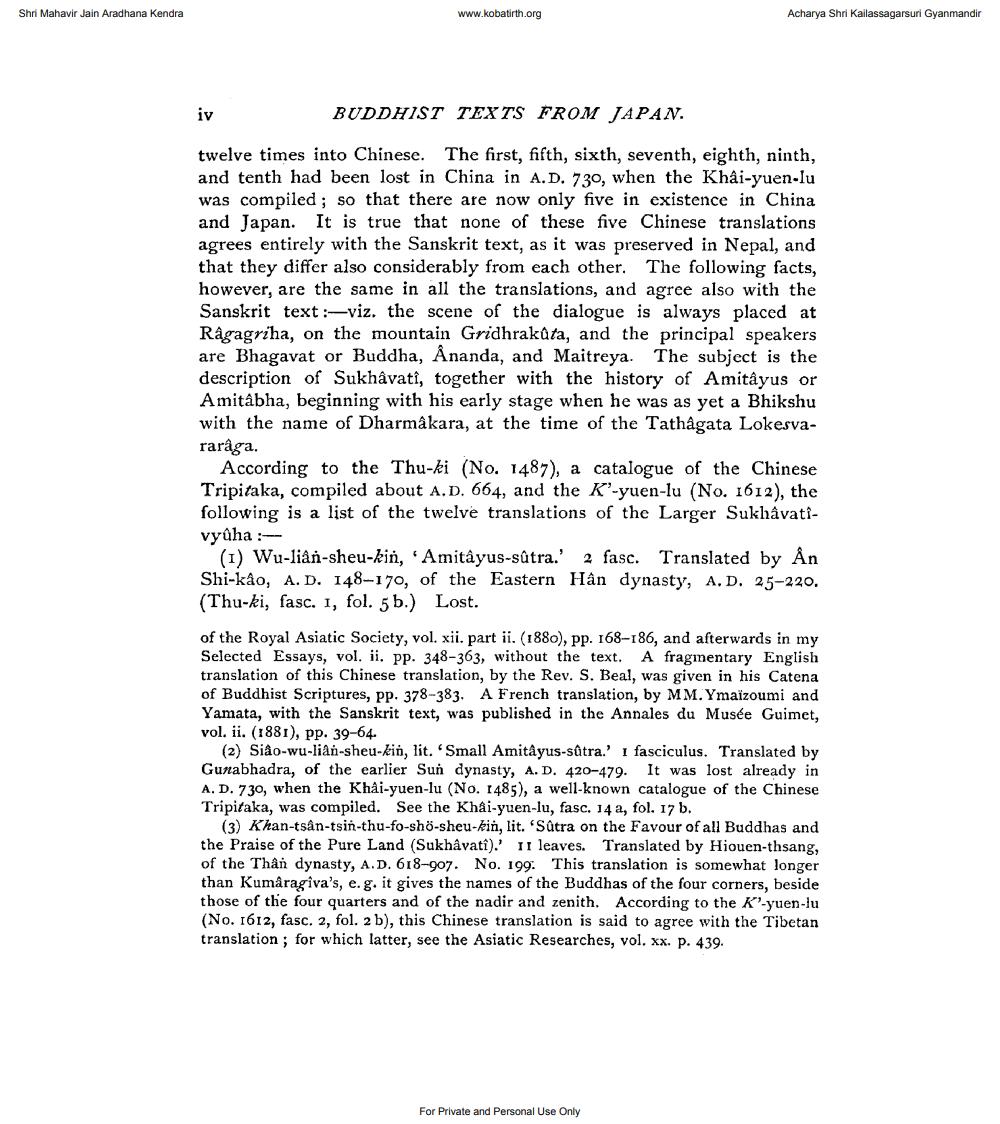________________
Shri Mahavir Jain Aradhana Kendra
www.kobatirth.org
Acharya Shri Kailassagarsuri Gyanmandir
BUDDHIST TEXTS FROM JAPAN.
twelve times into Chinese. The first, fifth, sixth, seventh, eighth, ninth, and tenth had been lost in China in A.D. 730, when the Khai-yuen-lu was compiled; so that there are now only five in existence in China and Japan. It is true that none of these five Chinese translations agrees entirely with the Sanskrit text, as it was preserved in Nepal, and that they differ also considerably from each other. The following facts, however, are the same in all the translations, and agree also with the Sanskrit text :-viz. the scene of the dialogue is always placed at Ragagriha, on the mountain Gridhrakůta, and the principal speakers are Bhagavat or Buddha, Ananda, and Maitreya. The subject is the description of Sukhâvati, together with the history of Amitäyus or Amitabha, beginning with his early stage when he was as yet a Bhikshu with the name of Dharmakara, at the time of the Tathagata Lokesvararåga.
According to the Thu-ki (No. 1487), a catalogue of the Chinese Tripitaka, compiled about A.D. 664, and the K'-yuen-lu (No. 1612), the following is a list of the twelve translations of the Larger Sukhâvativyûha :
(1) Wu-lian-sheu-kin, Amitâyus-sútra.' 2 fasc. Translated by Ån Shi-kâo, A.D. 148-170, of the Eastern Hân dynasty, A.D. 25-220. (Thu-ki, fasc. 1, fol. 5b.) Lost.
of the Royal Asiatic Society, vol. xii. part ii. (1880), pp. 168-186, and afterwards in my Selected Essays, vol. ii. Pp. 348-363, without the text. A fragmentary English translation of this Chinese translation, by the Rev. S. Beal, was given in his Catena of Buddhist Scriptures, pp. 378-383. A French translation, by MM. Ymaizoumi and Yamata, with the Sanskrit text, was published in the Annales du Musée Guimet, vol. ii. (1881), pp. 39-64.
(2) Siâo-wu-lian-sheu-kin, lit. 'Small Amitayus-sätra.' i fasciculus. Translated by Gunabhadra, of the earlier Sun dynasty, A.D. 420-479. It was lost already in A. D. 730, when the Khải-yuen-lu (No. 1485), a well-known catalogue of the Chinese Tripitaka, was compiled. See the Khâi-yuen-lu, fasc. 14 a, fol. 17 b.
(3) Khan-tsân-tsin-thu-fo-sho-sheu-kin, lit. 'Sutra on the Favour of all Buddhas and the Praise of the Pure Land (Sukhavatî).' II leaves. Translated by Hiouen-thsang, of the Thân dynasty, A.D. 618-907. No. 199. This translation is somewhat longer than Kumaragiva's, e.g. it gives the names of the Buddhas of the four corners, beside those of the four quarters and of the nadir and zenith. According to the K-yuen-lu (No. 1612, fasc. 2, fol. 2 b), this Chinese translation is said to agree with the Tibetan translation ; for which latter, see the Asiatic Researches, vol. xx. p. 439.
For Private and Personal Use Only




